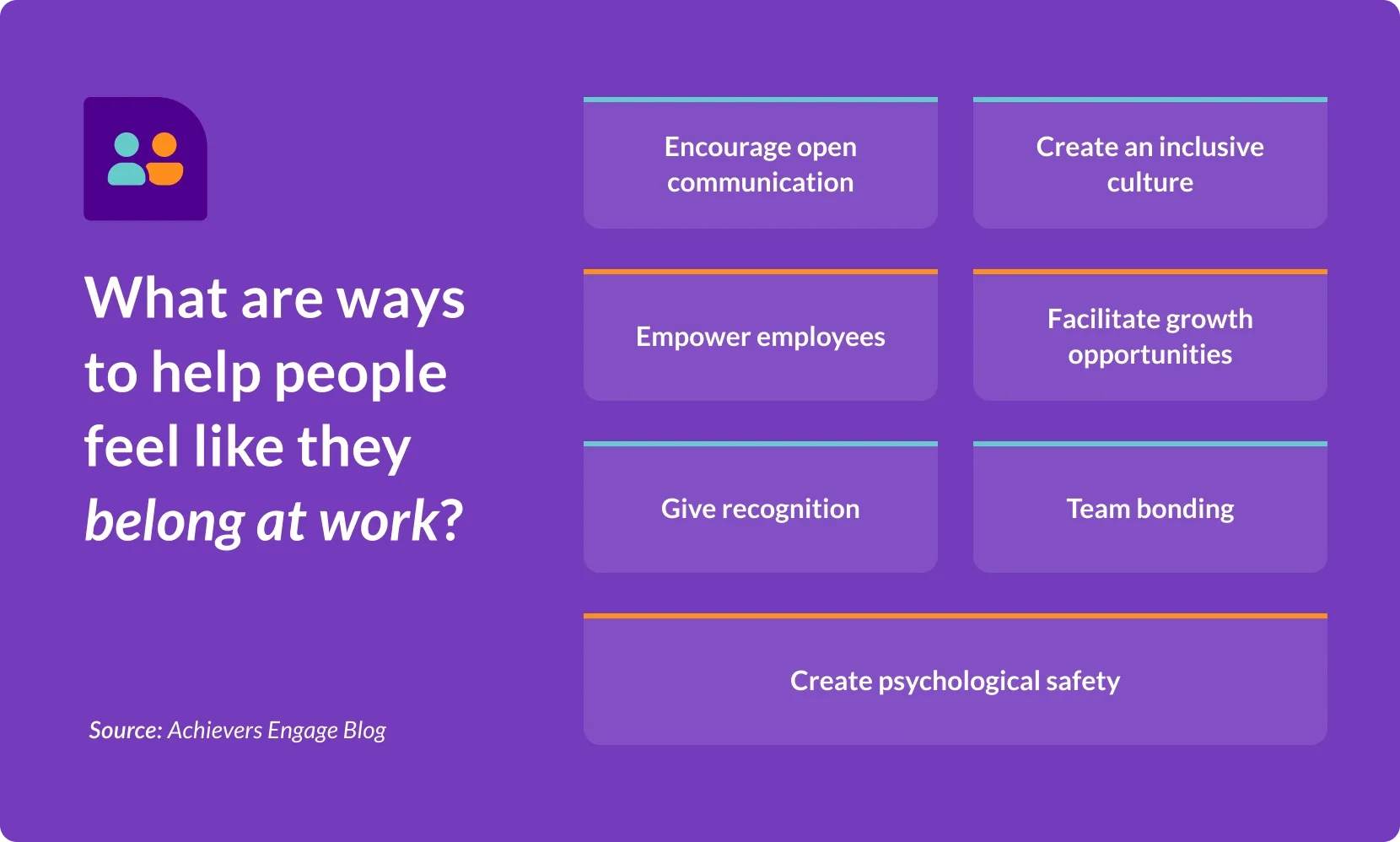Table of contents
Feeling a sense of belonging at work isn’t just a perk — it’s essential for a thriving workplace. In fact, a 2023 Work in America Survey found that 94% of workers consider it very important to feel they belong in their workplace. After all, when you’re connected to and secure within your community, whether that’s with family, close friends, or colleagues, you experience that vital sense of belonging — a feeling of being at home, where your true self is welcomed and safe.
But here’s the big question: Is your organization ready to commit to creating an environment where every team member feels that they truly belong? It’s a commitment worth making. Achievers Workforce Institute (AWI) research shows that employees who feel a strong sense of belonging are ten times more likely to recommend their organization as a great place to work and are genuinely enthusiastic about their jobs.
So, how do you cultivate this all-important sense of belonging within your company? Read on to discover practical strategies that can help you create a more inclusive and connected workplace.
What is a sense of belonging in the workplace?
A sense of belonging in the workplace is a profound experience of connection, security, and community that encompasses a feeling of being at home in one’s environment, free from hesitation or doubt. This sense of belonging is more than just a positive feeling; it represents the deepest measure of employee engagement and serves as a crucial indicator of an individual’s potential to thrive within an organization.
A genuine sense of belonging is a key driver of both individual and organizational success. According to AWI’s Belonging Blueprint, employees who experience a powerful sense of belonging are significantly more likely to be engaged in their roles. They are also more than twice as likely to demonstrate higher levels of productivity, resilience, and commitment to their company, as well as greater job satisfaction and enthusiasm for their work.
The business case for belonging at work
Belonging is a key driver of individual and organizational success. Fostering a strong sense of belonging can help struggling employees become thriving, productive, and happy team members once again. Based on AWI research, employees with a powerful sense of belonging are:
- 2x more engaged
- 2x more productive
- 2x more resilient
- 2x more satisfied with their jobs
- 2x more committed to their organization
Conversely, employees with a low sense of belonging are:
- 4x less likely to say they are engaged
- More likely to express lower levels of commitment, enthusiasm, productivity, and resilience

What are ways to help people feel like they belong at work?
1. Encourage open communication
Open communication is key to making employees feel like they truly belong at work. When teams embrace honest dialogue and transparent feedback, it creates an environment where everyone feels valued and heard. This openness fosters mutual respect and trust, allowing individuals to share their ideas and concerns without hesitation. As employees feel included and acknowledged, they become more engaged and connected to their work. By actively listening and embracing diverse perspectives, organizations build a culture where everyone’s contributions are celebrated, reinforcing a strong sense of belonging and commitment.
2. Create an inclusive culture
An inclusive culture is crucial for making employees feel like they truly belong at work. When organizations embrace diversity and respect everyone’s unique perspectives, it creates a welcoming environment where everyone feels valued. This acceptance allows team members to be their authentic selves, knowing they are free from discrimination. By ensuring that every voice is heard and appreciated, an inclusive culture fosters trust and strengthens connections among colleagues. This sense of belonging boosts morale and engagement, making employees feel deeply connected to their workplace and invested in its success.
3. Empower employees
Empowering employees is a powerful way to cultivate a sense of belonging at work. When individuals are given the freedom to make decisions and their ideas are genuinely valued, they develop a deeper connection to their roles and the organization. This trust in their abilities boosts confidence and reinforces their importance within the team. By involving employees in key decisions and celebrating their contributions, companies foster an environment where everyone feels integral to the success of the organization. This not only enhances engagement but also strengthens their commitment and sense of belonging.
4. Facilitate growth opportunities
Facilitating growth opportunities through employee development helps individuals feel like they belong by showcasing a commitment to their personal and professional advancement. When organizations offer training, mentorship, and career progression options, they affirm their investment in employees’ potential and future. This dedication fosters a sense of belonging, as employees feel valued and supported in their growth. By aiding employees in achieving their goals and advancing their careers, companies build an environment where individuals feel crucial to the team’s success and motivated to contribute fully, strengthening their connection to the workplace.
5. Give recognition
Giving recognition is crucial for fostering a sense of belonging at work. When employees are acknowledged for their contributions, it validates their efforts and reinforces their value within the team. Tools like Achievers make this process seamless by offering real-time recognition and personalized rewards, ensuring that accomplishments are celebrated consistently. This acknowledgment not only boosts morale but also deepens employees’ connection to the organization, making them feel integral to its success. By regularly highlighting achievements and using platforms like Achievers, companies create a supportive environment where everyone feels valued and included.
6. Create psychological safety
Psychological safety is essential for creating a sense of belonging at work. When employees feel safe expressing their ideas, asking questions, and admitting mistakes without fear of judgment or retaliation, they are more likely to engage fully and contribute authentically. This open environment fosters trust and respect, making individuals feel valued and integral to the team. By ensuring that everyone’s voice is heard, and their well-being is prioritized, psychological safety strengthens connections among colleagues and promotes a culture where people feel genuinely included and supported.
7. Team bonding
Team bonding enhances employees’ sense of belonging by building strong relationships and trust among colleagues. Activities that promote collaboration and shared experiences create a supportive environment where individuals feel connected and valued. When team members form personal connections, they are more likely to engage fully and feel included. This camaraderie boosts communication and collaboration, making employees feel like essential parts of the team. By prioritizing team bonding, organizations foster a positive workplace culture where everyone feels they belong and play a vital role in the team’s success.

What are the 5 pillars of belonging?
Cultivating this sense of belonging requires genuine effort in five key areas. The pillars of belonging, which all correlate positively and significantly with a stronger sense of belonging, include being:
“When organizations invest in the five pillars, each pillar becomes a 3x driver of the business outcomes our people programs are intended to deliver, such as engagement, productivity, and trust.” – David Bator, Managing Director, Achievers Workforce Institute
Activating the five pillars of belonging at work
A sense of belonging at work is incredibly valuable, but it’s difficult to define, much less create. To help you establish and support this important part of your organization’s culture, focus on the five pillars of belonging: feeling welcomed, known, included, supported, and connected.
1. Welcomed
First impressions are crucial, and if an employee feels like an outsider from the start, it can be difficult to change that. A thoughtful onboarding process is key to making new hires feel welcomed. Start by providing all necessary information and resources from day one, along with coaching from their manager. Facilitate connections with peers across the company and consider implementing an onboarding buddy or mentoring system to offer support, especially in the first few weeks.
Involving new employees early is also essential. Employee resource groups (ERGs) are a great way to build community and encourage active participation. These employee-led groups create fun, engaging opportunities for new hires to get involved and feel more connected to their organization from the outset.
To foster a sense of belonging in the workplace, it’s essential to introduce and integrate employees into the organizational culture and community. Here are several strategies to achieve this:
- Implement thoughtful, structured onboarding: Ensure onboarding is well-organized and carefully designed to support new employees effectively.
- Introduce organizational culture: Provide new hires with a comprehensive introduction to the unique values, norms, and practices of your organization.
- Invite to culture and team-building events: Encourage participation in events and activities that promote team bonding and immersion in the company culture.
Recognition action: Send a personalized recognition to new employees or team members on their first day of work.
2. Known
Your company may recognize the names and faces of its employees, but does it truly understand what they value and what they want from your organization? Showing that you do makes your team feel genuinely known and appreciated. It’s important to create an environment where employees feel comfortable opening up — when they do, listen closely and encourage them to share freely. These moments of connection are essential for building authentic relationships and fostering a sense of belonging.
Understanding your employees on this deeper level not only strengthens individual connections but also helps your organization achieve cultural alignment. When you know what truly matters to your team, you can ensure that everyone feels at home and comfortable in their roles. This deeper understanding fosters a more engaged, motivated, and cohesive workforce, leading to higher levels of satisfaction, productivity, and overall organizational success.
A sense of belonging at work means feeling understood, motivated, and celebrated as an individual. To foster this environment, consider implementing the following strategies:
- Use and integrate culture, values, or personality testing: Implement assessments to understand employees’ cultural fit, values, and personalities, and integrate these insights into their roles.
- Customize meeting and coaching styles: Tailor meeting formats and coaching approaches to align with each employee’s unique preferences and strengths.
- Encourage social events for personal connections: Promote social events, both in-person and online, to help employees build personal connections and strengthen team relationships.
Recognition action: Regularly recognize employees in alignment with their own personal values and interests.
3. Included
Inclusion means ensuring that every employee’s identity and experiences are both accepted and valued within the organization. It encompasses creating an environment where individuals feel that their unique perspectives are respected, and their contributions are meaningful. Inclusion goes beyond social interactions or who speaks up in meetings; it involves embedding diversity, equity, inclusion (DEI) principles into the organizational culture.
Inclusion is crucial because it directly impacts how employees perceive their value and acceptance in the workplace. By fostering an inclusive environment, you promote psychological safety, where employees feel comfortable expressing their true selves and sharing their opinions, even when they differ from the majority. This not only enhances their sense of belonging but also drives engagement and satisfaction. When employees see that their voices lead to tangible change, it reinforces their feeling of being genuinely known and valued.
Feeling valued and accepted without reservation is key to fostering a sense of belonging at work. To achieve this, consider implementing the following strategies:
- Regularly gather and share employee feedback: Collect feedback consistently and communicate the results to the team to keep everyone informed and involved.
- Encourage diverse social clubs and events: Offer a variety of social clubs and events, ensuring that all employees are invited to participate.
- Introduce and support Employee Resource Groups (ERGs): Establish ERGs to represent and support the diverse needs of all employees, fostering a sense of community and inclusion.
Recognition action: Recognize behaviors that promote a diversity of input and perspective.
4. Supported
Every employee should feel supported by their organization, their manager, and their teammates. A supportive environment requires empowering employees to succeed. Begin with providing all team members with the tools, training, and resources they need to succeed. You should also provide ways for your employees to grow, from training initiatives to a clear career path to the potential for new roles and responsibilities. And, of course, striving to establish a healthy work-life balance is one of the best ways to let employees know you have their backs on and off the job.
Leaders at your organization play an essential role in establishing a supportive, empowered environment as well. They must enjoy mutual trust with their direct reports, be comfortable taking risks, and develop and share clear expectations and guidelines. Emphasize the importance of coaching rather than micromanaging and the need to welcome and act on feedback from employees.
Consistently and meaningfully nurturing and developing talent is essential for fostering a sense of belonging at work. To achieve this, consider implementing the following strategies:
- Encourage regular, meaningful contact with managers: Foster frequent and impactful interactions between employees and their managers to build strong relationships.
- Empower managers to provide targeted coaching: Enable managers to offer coaching that addresses specific needs and helps employees grow effectively.
- Provide development resources for success: Ensure employees have access to the necessary resources and opportunities for development to excel in their roles.
Recognition action: Recognize employees for working toward growth and development goals.
5. Connected
The final pillar of belonging that your organization must focus on is the potential for employees to find meaningful personal connections at work. Connections between employees are wonderful when they happen naturally, but there are also actions you can take to facilitate them. The first is to make a diverse workforce a high priority for your organization. A diverse workforce ensures that every individual can see themselves represented within their organization, contributing to a feeling of psychological safety and resulting in a greater ability to form valuable, genuine connections.
You can also foster genuine connections by making time for team building activities. With an almost endless range of options available, it’s possible for every group to find exercises that they genuinely enjoy and lead to meaningful and longstanding relationships.
Developing and maintaining relationships across a diverse workforce is crucial for fostering a sense of belonging at work. To achieve this, consider implementing the following strategies:
- Prioritize developing a diverse workforce: Focus on building and supporting a diverse team to enrich the organizational culture.
- Facilitate cross-functional relationship building: Encourage interactions and collaboration between different departments and functions.
- Use connection tools to bridge gaps: Implement tools that help break down silos across functions, locations, and organizational levels.
Recognition action: Recognize actions that bring people together across business and demographic lines.
Provide recognition to foster belonging
Recognition is key to all five pillars of belonging, so your organization should encourage and enable all team members to practice frequent, real-time recognition, whether they’re in the office or working remotely. Employees recognized in the past week are almost five times as likely to have a strong sense of belonging as those who are never recognized.
Social recognition is the first and most important piece of the puzzle. Look for an employee recognition platform that allows employees to show appreciation whenever and wherever they prefer. The simplest way to provide monetary recognition, a necessary complement, is through a point-based rewards system — again, powered by an employee recognition platform. This allows employees to award points to others and redeem their own points for things they want, rather than giving them rewards that might collect dust on the shelf.
Create a workplace where everyone belongs with Achievers
Organizations that develop a culture of belonging are more likely to have committed employees that are enthusiastic about their work. Cultivating a culture of belonging is essential for every company and leader who wants an engaged and resilient team where each individual contributor feels valued and included.
To help leverage these pillars of belonging at your organization, rely on the Achievers Employee Engagement Platform. It includes Achievers Recognize, an employee recognition platform that makes it easy for everyone at your organization to provide meaningful, fun messages of recognition, together with reward points backed by the Achievers Reward Marketplace. And it also comes with Achievers Listen, an employee feedback software that makes capturing, analyzing, and acting on employee feedback a snap.
Integrating these tools into your organizational practices isn’t just about enhancing employee engagement and satisfaction — it’s about creating a workplace where everyone genuinely feels they belong. By adopting this comprehensive approach, you’re not only boosting morale but also laying the foundation for a vibrant, motivated workforce. Investing in these strategies is essential for building a thriving team that’s ready to achieve great things together.



